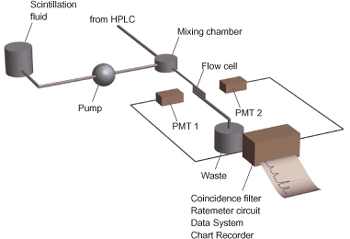Applications of Liquid Scintillation Counting
HPLC Flow Counting
Radiolabeled materials are often analyzed by chromatography. The original application of liquid scintillation counting to chromatographic techniques was to collect and count discrete fractions. This manner of counting is extremely laborious, and resolution is limited by the size of the fractions collected. Flow detectors were introduced to allow continuous LSC monitoring of column effluents. This gives extremely high-resolution results that are simultaneous with the separation. Modern flow detectors also have a switchable outflow, allowing radioactive peaks in the chromatogram to be collected for further analysis, or simply to sequester radioactive from nonradioactive waste.

| Product | Lipids/ CH3CN |
CH3CN: H2O 50:50 |
CH3OH: H2O 50:50 |
2M Ammonium Formate |
|---|---|---|---|---|
| Monoflow 1 | 55 | -- | -- | -- |
| Monoflow 2(3:1) | 45 | 43 | 45 | -- |
| Monoflow 3(2:1) | 40 | 38 | 40 | -- |
| Monoflow 4(3:1) | 45 | 43 | 45 | 43 |
| Monoflow 5(3:1) | 38 | 35 | 38 | -- |
| * Ratio of Monoflow product to sample | ||||
Flow detectors operate by passing a mixture of column effluent and scintillation cocktail through a transparent or translucent channel, which is monitored by a photomultiplier tube. The flow rates of effluent and cocktail are metered to provide a constant ratio, and the channel (generally a plastic tube) is coiled to cover the entire window area of the PMT. Cocktails for flow LSC must provide high efficiency, high sample capacity, and low viscosity. High efficiency allows for more sensitive detection and minimizes any decrease in signal due to sample composition or detector geometry.
The sample capacity is important because flow LSC tends to generate surprising amounts of waste materials. A typical HPLC flow rate is 1ml/min. Over an 8-hour day, continuous use of such a system will generate 480ml (1-day x 60 ml/hour x 8 hours) of spent solvent. If a low capacity cocktail is used (one which requires 10 volumes of cocktail per volume of sample), up to 5 liters of waste will be produced. Use of a high capacity cocktail (3:1, 2:1 or even 1:1 with National Diagnostics' Ecoscint Flow) will reduce this amount by up to 70% and keep disposal costs under control. Because of the large amounts of cocktails used, switching labeled peaks to a separate waste collection and using a biodegradable cocktail are recommended.
NEXT TOPIC: Liquid Scintillation and Radiation Safety
- Waste Disposal Issues in Scintillation Counting
- Preparing Tissue Samples for Scintillation Counting
- Preparing Samples in PAGE Gels for LSC
- Liquid Scintillation and Radiation Safety
- HPLC Flow Counting
- Counting Samples on Cellulose-Ester Filters
- Counting Samples from TLC Plates by LSC
- Counting Carbon Dioxide by LSC
- Assaying Discrete Samples by Liquid Scintillation Counting
